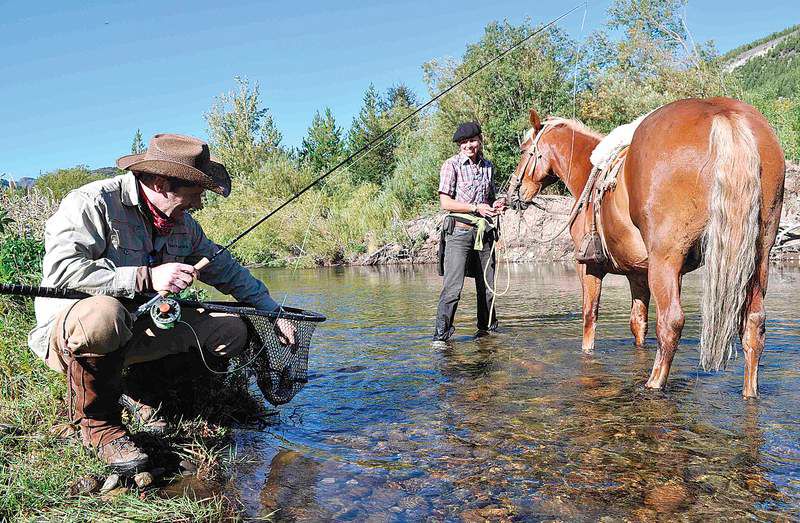Fishing from horseback
Published 4:00 am Thursday, February 24, 2011

- On the Coyhaique River in Chile, Gary Lewis caught this rainbow trout from the back of his horse, Colorin with a little help from Heather Barklow, of Glide.
Sometimes the horse is willing and sometimes the trout is willing, but not often at the same time.
Both the horse and trout were willing in 1997 on the Minam River in northeast Oregon. But the line was weak. When the trout made his second leap, my tippet broke.
Perhaps it was for the best. That horse didn’t mind that I carried a long stick and waved it around, but it might have had a change of heart when it saw a jumping, splashing rainbow at its heels.
A horse has the mental capacity of a 1,500-pound 2-year old. With a brain, good eyes and experience with things like snakes and dogs that nip at heels, it can tolerate a lot, but it might just throw a tantrum, which becomes what folks around here call a rodeo.
In 1999, on a pack trip to Ice Lake in Oregon’s Wallowa Mountains, I tried again. Barry Cox, of Enterprise, was the outfitter. When he returned to pack us out, I waited until he wasn’t looking and rode my bay into the water. The plan was to turn him around, make a long cast and troll the fly back.
I laid the fly on the surface. A brook trout charged, but turned away when he saw my steed.
Over the years, the goal became specific: to catch a wild trout on a dry fly from the back of a horse.
To Kevin and Therese Friedmann, and Heather Barklow, whom I met at the Fly Spur Ranch in Tumalo, where the logo is a trout fly entwined with a riding spur, the idea resonated.
When I met Joyce Norman, through our mutual friend, Brian Davis, she said she thought I could find a willing horse and willing trout in Patagonia.
If you’re asking, “Where is Patagonia?” let me save you the trouble of digging out the Atlas. Picture North America.
Locate my home of Bend, then go east to Salt Lake City, then southeast to Atlanta. From Atlanta, find your way down a narrow strip of land called Central America thence southerly to South America. Go down, down, down, where it is summertime during our winter and the land becomes a narrow finger pointed at Antarctica.
This, mi amigo, is Patagonia, land of the pampa, the Andes, verdant mountain valleys and fjords.
The horse, of course, came from Spain. The trout are the spawn of pioneers from Europe — German browns — and from Los Estados Unidos — our own rainbows, brought to Chile and Argentina in the early 1900s.
Two hours after I arrived at the Coyhaique River Lodge, I walked out, with a Cabela’s HDT 6-weight rod in hand. I didn’t know what HDT stood for, but I imagined it meant “Horse Duty for Trout.”
There stood Barklow and Norman. They had taken a trial run to see which of their horses would permit an angler on its back.
My steed, Heather told me, was Colorin, a Criollo. The ride was less than a mile to the river down a narrow switchbacked track.
Gaston Urrejola, the owner of the lodge, suggested a dry/dropper combination. I knotted a Schroeder’s Hopper to my tippet and added a beadhead Pheasant Tail tied off the bend of the hook on a 15-inch leader.
Out into the river, Heather and I coaxed the gelding. Mid-stream, I shook line out of the rod tip and questioned my sanity and my vanity.
It worked best to sit the horse mid-current and cast upstream. Right away, I missed a grab and moments later, hooked and lost a fish that took the nymph. The gelding, I imagined, asked himself what he was doing there in a sort of disinterested 2-year-old way.
Upstream, we found another hole, with trout in the tailout. Like their counterparts in North America, they split for deep water when they saw el caballo and the humans. I made longer casts, taking care to keep from wrapping line around the horse’s knees.
Gaston pointed to where the trees hung over the water. When my hopper splashed down, a trout swirled. The fish turned; I lifted the rod. The rainbow came out of the water time and again; its spotted flanks flashed silver and crimson.
After the second run, I brought it close to the horse and then dipped the long-handled net. The trout didn’t like the look of the horse and the horse didn’t like the look of the fish. They each tried to get away from the other, but my 4x tippet brought them back together.
With the fish at the horse’s heels again, I had it almost in the net and then thought better of it. There was a good chance that with a rainbow-striped torpedo aboard, mi caballo might try to push the eject button for both of us. I handed the net to Heather and steered the fish into it.
Heather wanted me to tell you not to try this at home.






